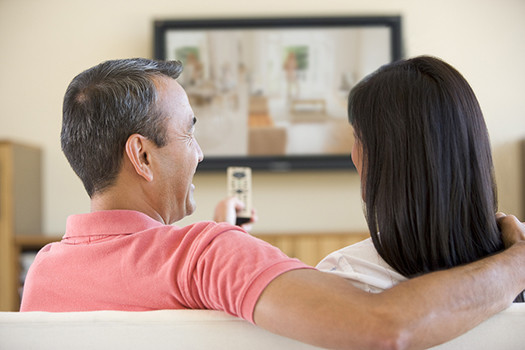“Watching” TV with a Visual Impairment

 Many unenlightened sighted people may wonder, “But if you can’t see, how can you watch TV?” If someone asks you this question, just smile, then wait until the next time they go into the kitchen to start dinner with their back turned but the TV on so they don’t miss anything. Pictures are nice, but in most plot-driven stories or educational documentaries, it’s the dialogue or narration that conveys most of what’s going on. Which is not to say a bit of scene and action description cannot add to your viewing enjoyment. Happily, more and more programs are making use of the Secondary Audio Programming (SAP) broadcast capabilities to include an audio description track.
Many unenlightened sighted people may wonder, “But if you can’t see, how can you watch TV?” If someone asks you this question, just smile, then wait until the next time they go into the kitchen to start dinner with their back turned but the TV on so they don’t miss anything. Pictures are nice, but in most plot-driven stories or educational documentaries, it’s the dialogue or narration that conveys most of what’s going on. Which is not to say a bit of scene and action description cannot add to your viewing enjoyment. Happily, more and more programs are making use of the Secondary Audio Programming (SAP) broadcast capabilities to include an audio description track.
Unfortunately, all too often the controls to enable video description are buried several layers deep in the TV or cable box remote. The good news is that all of this is about to change for the better. The Twenty-First Century Communications and Video Accessibility Act of 2010 includes a number of provisions regulating the production and availability of accessible broadcast media and devices—which is to say, television sets, set-top boxes, digital video recorders (DVRs) and descriptive video for broadcast and non-broadcast channel programming.
Currently, the top four broadcast networks—ABC, CBS, Fox, and NBC—are required to provide 50 hours per calendar quarter of video-described prime time or children’s programming, or approximately four hours each week. This requirement also applies to the top five cable networks. Currently, these top five include USA, Disney Channel, TNT, Nickelodeon, and TBS.
Local ABC, CBS, Fox, and NBC affiliates in the top US 25 markets are required to own and operate the equipment to broadcast this network-provided video description. They must also provide 50 hours of video-described prime time or children’s programming per quarter. On July 1, 2016, the regulations will expand to cover local network affiliates in the 26th through 60th markets.
Cable and satellite companies that serve 50,000 or more subscribers must also own and operate the equipment necessary to broadcast video description. Of course, no amount of descriptive video is going to make much of a difference if the controls are inaccessible. That’s why the Twenty-First Century Communications and Video Accessibility Act of 2010 also includes accessible device standards which apply to all new TV sets, cable boxes and DVRs manufactured after December 2016.
These standards include accessible device setup, program guides, channel and volume selection, and more. For a complete rundown of this groundbreaking legislation, check out the January 2015 AccessWorld article, Is Accessible TV Viewing Finally on Its Way?
To date, there are several devices that already incorporate some but not all of these new accessibility enhancements. Many new Samsung TV models include a built-in voice guide, and Comcast now offers a talking TV interface, available at no extra charge to their DVR customers with visual impairments. If you are not a Comcast customer and you would rather wait for the new regulations to go into effect before investing in a new set, there are still a few ways to increase the accessibility and enjoyment of your television experience.
This article was written and published by the American Foundation for the Blind. To read the rest of the article, you can visit this link https://www.afb.org/blindness-and-low-vision/using-technology/using-technology-entertainment-guide-people-visual-0
We Are Here To Help
If you or a loved one have been diagnosed with Macular Degeneration, we have prepared a 12-part eBook <Click here to download a PDF of the entire report.>
To learn more about how we can Bring Hope to people who are blind or with low vision, contact a Technology Specialist at New England Low Vision and Blindness to learn more. You can also call our toll free number 888-211-6933 or email us at info@nelowvision.com.
Our two(2) state-of-the-art technology showrooms are a wonderful resource, showcasing a variety of leading electronic low vision magnifiers and blindness products. You can schedule an appointment with one of our Technology Specialist who can help you find the right technology, training and care solution.
If you cannot come to us, our staff can even drive out and bring our Vision Store to you, for a no-obligation product demonstration. We offer a comprehensive line of products including electronic magnification low vision aids, blindness products, and leading low vision products for people with glaucoma, macular degeneration and other forms of vision loss.



